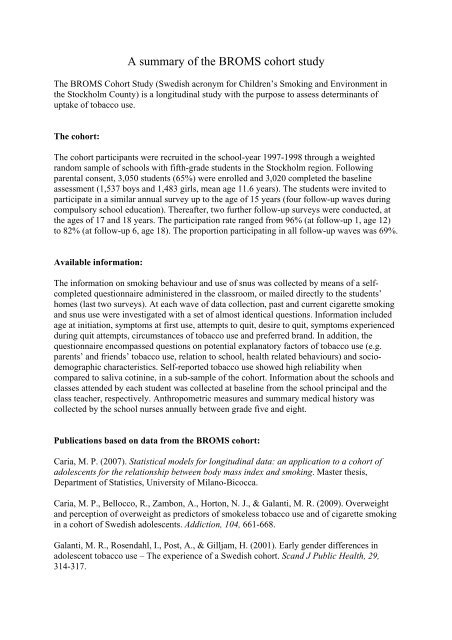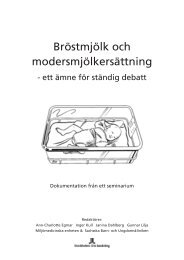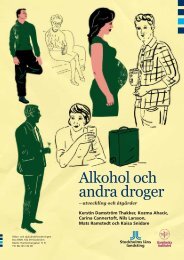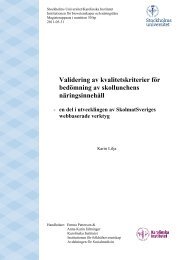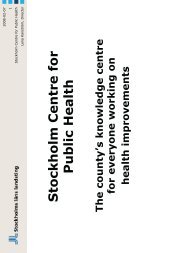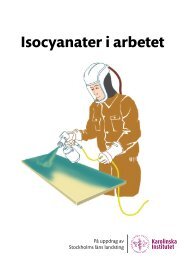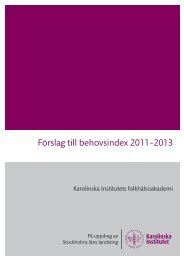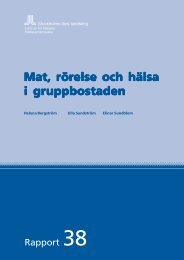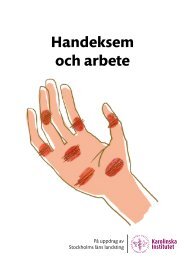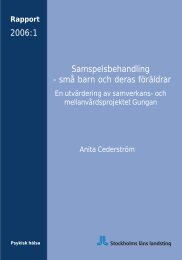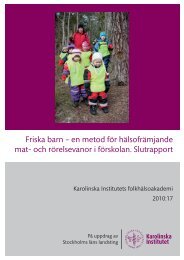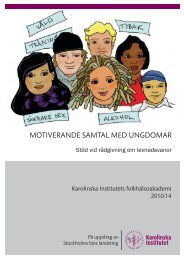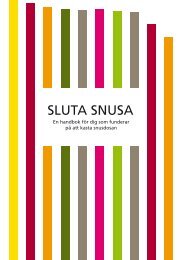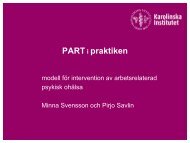You also want an ePaper? Increase the reach of your titles
YUMPU automatically turns print PDFs into web optimized ePapers that Google loves.
A <strong>summary</strong> <strong>of</strong> <strong>the</strong> <strong>BROMS</strong> <strong>cohort</strong> <strong>study</strong>The <strong>BROMS</strong> Cohort Study (Swedish acronym for Children’s Smoking and Environment in<strong>the</strong> Stockholm County) is a longitudinal <strong>study</strong> with <strong>the</strong> purpose to assess determinants <strong>of</strong>uptake <strong>of</strong> tobacco use.The <strong>cohort</strong>:The <strong>cohort</strong> participants were recruited in <strong>the</strong> school-year 1997-1998 through a weightedrandom sample <strong>of</strong> schools with fifth-grade students in <strong>the</strong> Stockholm region. Followingparental consent, 3,050 students (65%) were enrolled and 3,020 completed <strong>the</strong> baselineassessment (1,537 boys and 1,483 girls, mean age 11.6 years). The students were invited toparticipate in a similar annual survey up to <strong>the</strong> age <strong>of</strong> 15 years (four follow-up waves duringcompulsory school education). Thereafter, two fur<strong>the</strong>r follow-up surveys were conducted, at<strong>the</strong> ages <strong>of</strong> 17 and 18 years. The participation rate ranged from 96% (at follow-up 1, age 12)to 82% (at follow-up 6, age 18). The proportion participating in all follow-up waves was 69%.Available information:The information on smoking behaviour and use <strong>of</strong> snus was collected by means <strong>of</strong> a selfcompletedquestionnaire administered in <strong>the</strong> classroom, or mailed directly to <strong>the</strong> students’homes (last two surveys). At each wave <strong>of</strong> data collection, past and current cigarette smokingand snus use were investigated with a set <strong>of</strong> almost identical questions. Information includedage at initiation, symptoms at first use, attempts to quit, desire to quit, symptoms experiencedduring quit attempts, circumstances <strong>of</strong> tobacco use and preferred brand. In addition, <strong>the</strong>questionnaire encompassed questions on potential explanatory factors <strong>of</strong> tobacco use (e.g.parents’ and friends’ tobacco use, relation to school, health related behaviours) and sociodemographiccharacteristics. Self-reported tobacco use showed high reliability whencompared to saliva cotinine, in a sub-sample <strong>of</strong> <strong>the</strong> <strong>cohort</strong>. Information about <strong>the</strong> schools andclasses attended by each student was collected at baseline from <strong>the</strong> school principal and <strong>the</strong>class teacher, respectively. Anthropometric measures and <strong>summary</strong> medical history wascollected by <strong>the</strong> school nurses annually between grade five and eight.Publications based on data from <strong>the</strong> <strong>BROMS</strong> <strong>cohort</strong>:Caria, M. P. (2007). Statistical models for longitudinal data: an application to a <strong>cohort</strong> <strong>of</strong>adolescents for <strong>the</strong> relationship between body mass index and smoking. Master <strong>the</strong>sis,Department <strong>of</strong> Statistics, University <strong>of</strong> Milano-Bicocca.Caria, M. P., Bellocco, R., Zambon, A., Horton, N. J., & Galanti, M. R. (2009). Overweightand perception <strong>of</strong> overweight as predictors <strong>of</strong> smokeless tobacco use and <strong>of</strong> cigarette smokingin a <strong>cohort</strong> <strong>of</strong> Swedish adolescents. Addiction, 104, 661-668.Galanti, M. R., Rosendahl, I., Post, A., & Gilljam, H. (2001). Early gender differences inadolescent tobacco use – The experience <strong>of</strong> a Swedish <strong>cohort</strong>. Scand J Public Health, 29,314-317.
Galanti, M. R., Rosendahl, I., & Wickholm, S. (2008). The development <strong>of</strong> tobacco use inadolescence among “snus starters” and “cigarette starters”: An analysis <strong>of</strong> <strong>the</strong> Swedish“<strong>BROMS</strong>” <strong>cohort</strong>. Nicotine & Tobacco Research, 10, 315-323.Post, A. (2009). Issues <strong>of</strong> validity in longitudinal studies <strong>of</strong> youth tobacco use. Doctoraldissertation. The Department <strong>of</strong> Public Health Sciences, Karolinska Institutet, Stockholm,Sweden.Post, A., Galanti, M. R., & Gilljam, H. (2003). School and family participation in alongitudinal <strong>study</strong> <strong>of</strong> tobacco use. Some methodological notes. European Journal <strong>of</strong> PublicHealth, 13, 75-76.Post, A., Gilljam, H., Bremberg, S., & Galanti, M. R. (2008). Maternal smoking duringpregnancy: a comparison between concurrent and retrospective self-reports. Paediatric andPerinatal Epidemiology, 22, 155-161.Post, A., Gilljam, H., Rosendahl, I., Bremberg, S., & Galanti, M. R. (In press). Symptoms <strong>of</strong>nicotine dependence in a <strong>cohort</strong> <strong>of</strong> Swedish youths: a comparison between smokers,smokeless tobacco users and dual tobacco users.Post, A., Gilljam, H., Rosendahl, I., Meurling, L., Bremberg, S., & Galanti, M. R. (2005).Validity <strong>of</strong> self reports in a <strong>cohort</strong> <strong>of</strong> Swedish adolescent smokers and smokeless tobacco(snus) users. Tobacco Control, 14, 114-117.Rosendahl, I. (2005). Modeling individual behavioral changes: <strong>the</strong> case <strong>of</strong> tobacco uptake ina <strong>cohort</strong> <strong>of</strong> school children. Doctoral dissertation. The Division <strong>of</strong> Epidemiology, Institute <strong>of</strong>Environmental Medicine, Karolinska Institutet, and Stockholm Centre for Public Health –Tobacco Prevention, Stockholm, Sweden.Rosendahl, K. I., Galanti, M. R., Gilljam, H., & Ahlbom, A. (2003). Smoking mo<strong>the</strong>rs andsnuffing fa<strong>the</strong>rs: behavioural influences on youth tobacco use in a Swedish <strong>cohort</strong>. TobaccoControl, 12, 74-78.Rosendahl, K. I., Galanti, M. R., Gilljam, H., & Ahlbom, A. (2005). Knowledge abouttobacco and subsequent use <strong>of</strong> cigarettes and smokeless tobacco among Swedish adolescents.Journal <strong>of</strong> Adolescent Health, 37, 224-228.Rosendahl, K. I., Galanti, M. R., Gilljam, H., Bremberg, S., & Ahlbom, A. (2002). School andclass environments are differently linked to future smoking among preadolescents. PreventiveMedicine, 34, 649-654.


